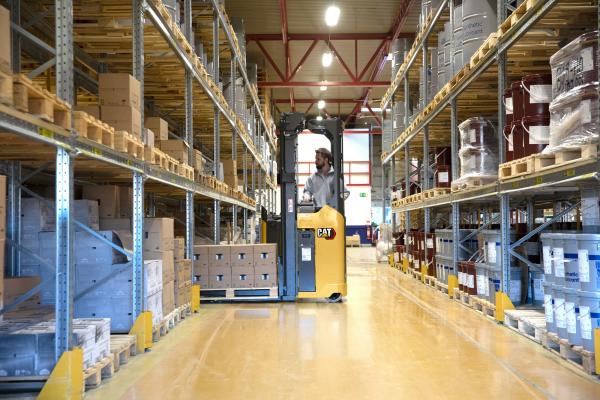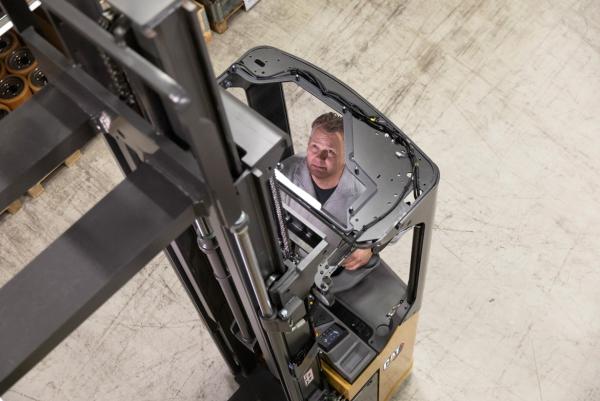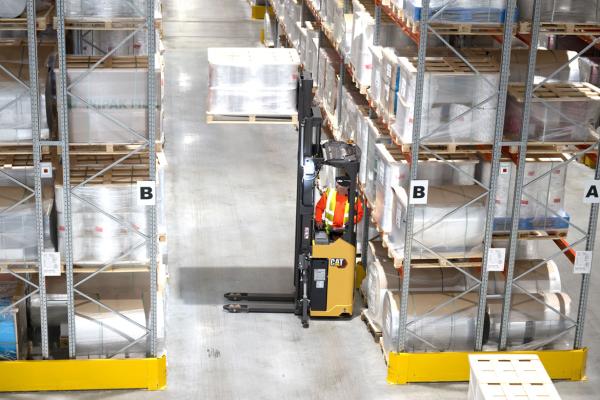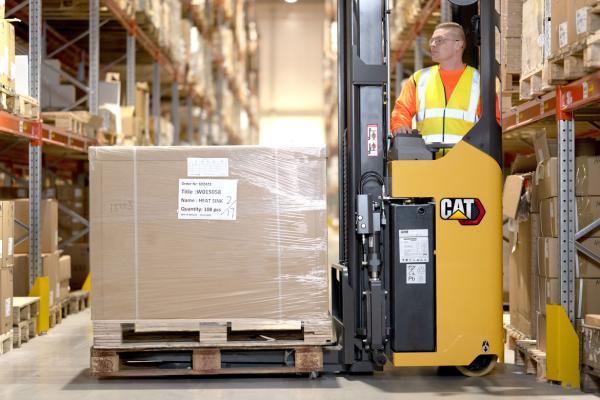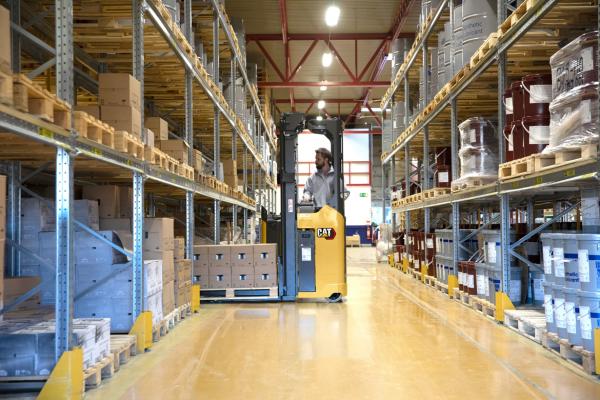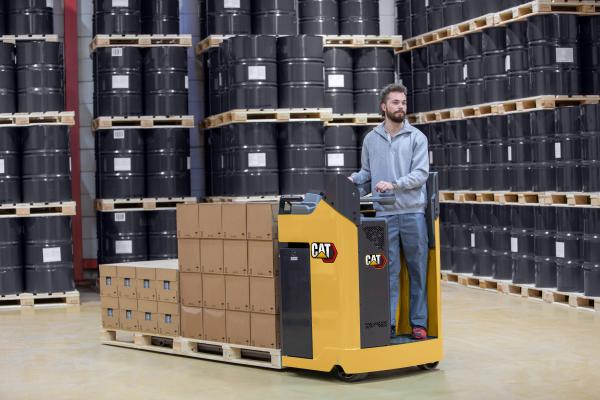Your choice of lift truck makes a huge difference to the productivity of your materials handling operation.
How do some trucks get the work done much faster than others?
Well, it’s not all about power ratings and top speeds. If it was, forklift truck makers would simply fit bigger motors to their products. There’s no limit to how fast they could go. But extra speed without extra control and safety makes no sense.
For forklift designers, increasing materials handling output is often more about avoiding:
- Collisions with structures, objects and people
- Spillage and damage of goods
- Overturning of the truck
These are things that seriously slow down operations and reduce profits. Below we list some of the key design aims for a faster lift truck.
Key design aims for a faster lift truck
- Manoeuvrability – so operators can easily get around and between buildings, racking aisles and obstacles without hitting them
- Ergonomics – enabling the operator to adopt a position with minimum strain and a relaxed body, which allows him or her to work more efficiently
- Vision and precision – allowing clear views of each situation, and accurate positioning of the truck and its forks
- Smooth control – for firm but gentle treatment of potentially breakable loads
- Safety and protection – including prevention of dangerous operator behaviour, and defence against injury
For a real-life illustration of these design factors, let’s look at one of the latest products from Cat® Lift Trucks. The Cat® NSR12-20N2(I) stand-in stacker range meets ‘faster lift truck’ design aims in the following ways and more:
Lift truck manoeuvrability
A compact footprint is essential to manoeuvrability in restricted spaces. Stand-in models are even more compact than platform stackers – and there are no delays for folding and unfolding of platforms and sidebars. What’s more, the stand-in stacker operator is fully contained within the truck’s structure. There’s no fear of banging an arm or leg against the racking. Operators can therefore drive quickly and confidently through narrow aisles.
Forklift ergonomics
The stand-in stackers’ design allows operators to adopt an ergonomic posture. It allows them to move and turn their body in the direction of travel with their neck angle reduced to a minimum. Many other features help in optimising the body position for every situation. They include the spacious cabin, positionally adjustable armrest and steering wheel, and optical presence sensor. Further aids, like a panoramic transparent overhead guard and a foldable seat, are available as options. Ergonomic design does more than just reduce risk of RSI and its related costs. It minimises physical tiredness, allowing the operator to focus fully on the materials handling task. Great ergonomics is therefore an investment in productivity and efficiency.
Fork-tip vision and precision
Every potential obstacle to all-round and fork-tip visibility is minimised by careful design. That includes the mast, fork carriage, overhead guard, pillars and chassis. Materials and coatings with low-reflection surfaces have been chosen to avoid visual disturbance by glare. For applications where operators regularly drive long distances with forks trailing, speed controls can be optionally repositioned. This enables easier use and clearer vision in the chosen direction of travel.
With the stand-in stackers’ progressive electric power steering, sensitivity of control is automatically adjusted according to speed. When moving slowly, it provides high precision for tight manoeuvres. When travelling fast and straight, it maintains stability by smoothing out the response to steering wheel movements.
Ergonomic controls enable precise drive and hydraulic actions. Tapered forks with angled tips are easy to slot quickly and smoothly into pallets, without damage. Optional aids, like a laser fork height indicator, can increase the speed and accuracy of fork positioning at any level. A more sophisticated option is the level assistance system (LAS). LAS offers a simple, fast way of choosing whether to stop at each pre-set height or bypass it.
Smooth control
The same ergonomic controls are linked to the latest advances in AC motor and electronic controller technology. They make all travel, lifting and lowering movements faster and smoother. An adjustable armrest comfortably supports the user’s wrist and positions his or her hand optimally for smooth, accurate control. It also allows simultaneous operation of the thumbwheel throttle, fingertip hydraulic levers and other controls. This is a further time saver. Meanwhile, the stand-in stacker’s many other ergonomic and comfort features help maintain consistent performance, hour after hour, by minimising fatigue.
Lift truck safety and protection
Slowing down when turning is essential to keeping the truck and its load stable. The automatic cornering control on these trucks prevents operators from taking turns too fast. At the same time, it enables them to turn at an optimum speed – with a maximum automatically set according to steering angle. This means the operator can make quick, safe and confident turns, rather than slowing excessively and over-cautiously.
Safe speeds for drive and hydraulic functions depend on who is driving and what they are handling. Programmability and performance mode options allow different limits to be set for each operator and application. For example, they can be reduced for inexperienced operators and delicate goods. Meanwhile, the best drivers can be allowed to work faster.
In conclusion, faster materials handling requires a combination of operating quickly, adopting an ergonomic posture, and avoiding collisions, spills and overturns. The features and functions summarised in this article give operators confidence to work quickly. Ultimately, they must also feel they are protected, while moving at speed, by the quality and robustness of the truck. With their heavy-duty chassis, integrated bumper and high-strength overhead guard, Cat stand-in stackers leave users in no doubt.
Time saving with Li-ion technology
It’s worth mentioning that these stackers get through their work even faster when you choose lithium-ion (Li-ion) batteries. Unlike lead-acid batteries, they need no daily maintenance or battery changes. Time saved can be directly invested into materials handling operations. Fast charging during regular breaks and pauses in the operation keeps the truck constantly ready for action. Another advantage over lead-acid is that Li-ion batteries keep the truck speed consistent even at low states of charge. This further increases productivity.
Click here for further information on the fast and safe Cat NSR12-20N2(I) stand-in stacker range.
